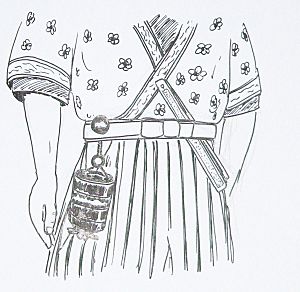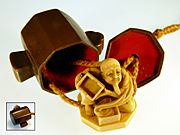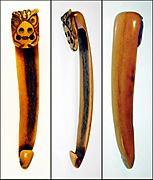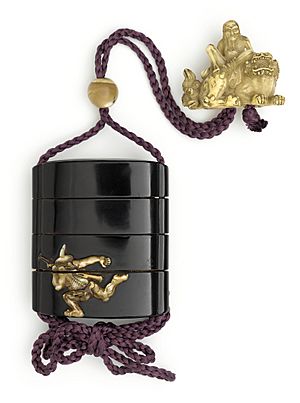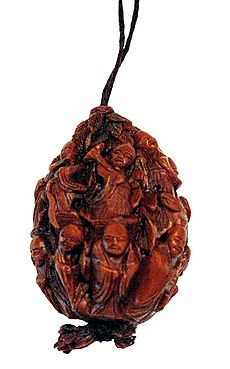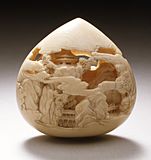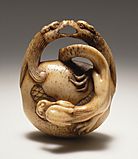Netsuke facts for kids
Netsuke (say "NET-soo-keh") are tiny sculptures that were first made in Japan in the 1600s. They had a special job: to help people carry their things!
Contents
History of Netsuke
Long ago, traditional Japanese clothes like kimono didn't have pockets. But men still needed to carry personal items, such as pipes, tobacco, money, or medicine.
So, they came up with a clever idea! They put their belongings into small containers called sagemono. These containers would hang from their robes' sashes (called obi) using cords. The most popular containers were beautiful boxes known as inrō. These boxes were kept closed by sliding beads called ojime on the cords.
To stop the cord and container from falling off the sash, they used a special carved button-like toggle. This toggle was called a netsuke. It held everything securely in place.
Over time, netsuke changed from just being useful objects to amazing works of art. They showed off incredible skill and craftsmanship. These tiny sculptures often tell stories about Japanese folklore and daily life. Netsuke were most popular during Japan's Edo period, from about 1615 to 1868. Even today, people still create netsuke, and some modern pieces can be very valuable. You can also find good copies in museums and souvenir shops.
Sometimes, the same artists who made netsuke also created Okimono. These were small, decorative sculptures that didn't have a practical use.
What Does "Netsuke" Mean?
The word netsuke comes from two Japanese words: ne, meaning "root," and tsuke, meaning "to attach." So, it means "root to attach."
Different Kinds of Netsuke
There are many different shapes and styles of netsuke:
- katabori-netsuke (sculpture netsuke) - This is the most common type. They are small, round, three-dimensional figures, usually about one to three inches tall.
- anabori-netsuke (hollowed netsuke) - These are a type of katabori that are carved to have a hollow space inside. Clams are often the design for these.
- sashi-netsuke (stab netsuke) - These are long and thin, like sticks. They are about six inches long.
- obi-hasami - Another long netsuke with curved ends. It sits behind the obi (sash) with the curved parts showing above and below.
- men-netsuke (mask netsuke) - These are often copies of larger noh masks. They are the second most common type after katabori.
- manjū-netsuke - These are thick, flat, and round, often with carvings that stick out (in relief). They look like a Japanese sweet called a manjū.
- ryūsa-netsuke - Shaped like a manjū, but carved with openwork, so light can shine through them.
- kagamibuta-netsuke (mirror-lid netsuke) - These also look like a manjū, but they have a metal disc on top that acts like a lid for a shallow bowl, usually made of ivory. The metal part is often beautifully decorated.
- karakuri-netsuke (trick/mechanism netsuke) - Any netsuke that has moving parts or hidden surprises!
Materials Used for Netsuke
Netsuke were made from many different materials:
- Ivory - This was a very common material until it became illegal to use ivory from live animals. Today, netsuke are sometimes made from mammoth ivory, which is found underground.
- Boxwood and other hardwoods - These were popular in old Japan and are still used today.
- Metal - Often used for small details or for the lids of kagamibuta netsuke.
- Hippopotamus tooth - Used today as a replacement for ivory.
- Wild boar tusk - Often used by certain carvers.
- Rhinoceros horn
- Clay or porcelain
- Lacquer
- Cane (woven)
Special Materials
Some netsuke are made from very unusual materials:
- Hornbill ivory: This comes from the casque (a helmet-like growth) on the head of the helmeted hornbill bird. It's not true ivory, but it's hard and carvable. It's usually creamy yellow with red parts.
- Umimatsu: This is a type of black coral. It has a dense texture and can have amber or reddish colors mixed in with the black. It was tricky for carvers to use because it could crack or chip easily.
- Umoregi: This is a type of partially fossilized wood, often called "jet." It looks like black wood but has no grain. It can be polished to be very shiny but tends to split. Umoregi is petrified wood from ancient cedar and pine trees that were buried and turned into a hard, dark material over millions of years.
- Walrus tusk: Walruses have two long tusks. These have been carved for centuries. Walrus tusk netsuke often have a mottled, almost see-through part inside that is harder to carve.
- Whale's tooth: The sperm whale has large teeth that can be carved.
- Whale bone: All bones are hollow. Whale bone can be identified by tiny holes or narrow channels when cut. It is less shiny than ivory.
- Other teeth: Teeth from boars, bears, and even tigers were also used.
- Tagua nut: This nut comes from the ivory palm tree and is often called "vegetable ivory." It's very hard when dry and can be carved into beautiful items.
- Walnut (or kurumi): Sometimes, the actual walnut shell was carved. The nut meat was removed, and then detailed designs were carved into the shell.
- Bamboo: Pieces of bamboo stem or root were carved into netsuke. These are not very common.
- Agate: A mineral with many colors that can be polished to a high shine.
- Ivorine: This material is made from the dust of legally obtained ivory, tusks, and teeth, mixed with clear resin. It was created to meet the demand for netsuke after new ivory became illegal. It can be carved like ivory but doesn't have the natural lines of animal ivory.
What Do Netsuke Show?
Netsuke show us a lot about Japanese society and culture. Because Japan was isolated for a long time, netsuke became a way for artists to express themselves. They show almost every part of Japanese life, including:
- People - Famous people, ordinary people, historical figures, children, warriors, and priests.
- Crafts, trades, and jobs - Often showing people doing their work, like fishermen catching fish or woodcutters chopping wood.
- Animals - Including animals from the zodiac and other creatures. Some octopus netsuke might even have nine tentacles instead of eight!
- Plants or plant products - Small items like beans or chestnuts are often carved to look like their real size.
- Gods and mythical creatures - Many come from Chinese stories and religions, as well as the Seven Lucky Gods from Japanese mythology.
- Non-living things - This is the smallest group. Examples include roof tiles, coins, and tools.
- Abstract designs - Patterns and other designs.
Some netsuke are simple objects, while others show whole scenes from history, myths, or famous stories.
-
A Kirishitan netsuke showing Christ, from the 17th century.
-
Netsuke with Fukurokuju, Benten, and a boy.
Images for kids
-
An ivory netsuke with an eagle design and an inro with a deer design. The two pieces together tell a story of an eagle hunting deer. Edo period, 18th century.
See also
 In Spanish: Netsuke para niños
In Spanish: Netsuke para niños



